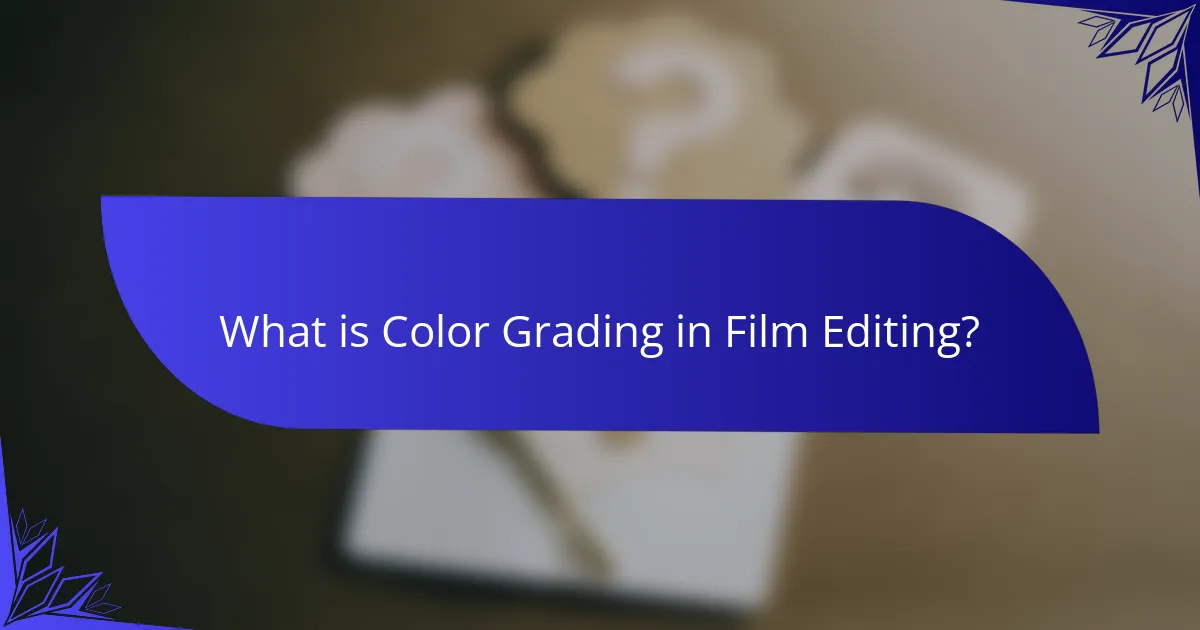Color grading in film editing is the process of adjusting the color of footage to enhance the visual tone and mood of a film. This technique involves modifying brightness, contrast, saturation, and color balance, significantly impacting storytelling by influencing emotional responses and reinforcing narrative themes. Key techniques include primary color correction, secondary color correction, and color matching, all performed using specialized software such as DaVinci Resolve, Adobe Premiere Pro, and Final Cut Pro. The article will explore these techniques and software, highlighting their importance in creating specific atmospheres and ensuring visual coherence throughout a film. Additionally, it will discuss the relationship between color choices and audience engagement, underscoring the role of effective color grading in enhancing the overall viewing experience.

What is Color Grading in Film Editing?
Color grading in film editing is the process of adjusting the color of footage. It enhances the visual tone and mood of a film. Color grading involves modifying brightness, contrast, saturation, and color balance. This technique helps create a specific atmosphere or emotional response. Professional color grading is typically performed using specialized software. Popular software includes DaVinci Resolve and Adobe Premiere Pro. The process can significantly impact storytelling by reinforcing themes and character arcs. For example, warmer tones may evoke feelings of nostalgia, while cooler tones can create tension.
How does color grading influence the overall aesthetic of a film?
Color grading significantly influences the overall aesthetic of a film. It enhances visual storytelling by manipulating colors to evoke specific emotions. Different color palettes can set the mood and tone of a scene. For example, warm tones often create feelings of comfort, while cool tones can evoke sadness or tension. Color grading also ensures visual consistency across scenes, maintaining the film’s narrative flow. Research shows that color can affect audience perception and engagement. A study by the University of California found that viewers’ emotional responses varied with color choices. Thus, effective color grading is essential for creating a cohesive and impactful film experience.
What are the key principles behind effective color grading?
Effective color grading relies on several key principles. The first principle is understanding color theory. This includes knowledge of the color wheel, complementary colors, and color harmony. The second principle is establishing a mood or tone. Color grading should enhance the emotional impact of a scene. The third principle is consistency throughout the project. This ensures that colors match across different shots and scenes. The fourth principle is attention to detail. Small adjustments can significantly affect the overall image. The fifth principle is utilizing software tools effectively. Familiarity with color grading software is crucial for achieving desired results. Each of these principles contributes to creating a cohesive visual narrative.
How does color grading affect viewer perception and emotions?
Color grading significantly influences viewer perception and emotions. It alters the mood and tone of visual content. For instance, warmer tones can evoke feelings of comfort and happiness. Conversely, cooler tones may create a sense of sadness or tension. Research shows that color can affect psychological responses. A study by Elliot and Maier (2014) indicates that colors can influence emotional states and decisions. Color grading also helps establish a narrative context. It can enhance themes and character development in storytelling. Therefore, effective color grading is essential in film editing to guide viewer emotions and perceptions.
Why is color grading essential in film production?
Color grading is essential in film production because it enhances the visual storytelling and emotional impact of a film. It allows filmmakers to manipulate color and contrast to create a specific mood or atmosphere. This process can highlight themes and character development. For example, warm tones may evoke feelings of comfort, while cool tones can create tension. Studies show that color influences audience perception and emotional responses. Proper color grading can also ensure consistency across different scenes. This technique helps maintain the film’s visual coherence. Ultimately, color grading is a critical step in achieving the desired artistic vision.
What role does color grading play in storytelling?
Color grading significantly influences storytelling by enhancing the emotional tone of a film. It helps establish mood and atmosphere through color choices. For instance, warm colors can evoke feelings of comfort or nostalgia, while cool colors may create tension or unease. Color grading also aids in visual continuity, ensuring that scenes flow seamlessly. Additionally, it can highlight character development by using different color palettes for various arcs. Studies show that color perception affects audience emotions and responses. Therefore, effective color grading is crucial in guiding viewer interpretation and engagement with the narrative.
How can color grading enhance character development?
Color grading can enhance character development by visually representing a character’s emotional state. Different color palettes evoke specific feelings and traits. For instance, warm colors like reds and oranges may suggest passion or aggression. Conversely, cooler colors such as blues and greens can convey calmness or sadness.
Filmmakers often use color grading to signify a character’s journey. A character’s transformation might be highlighted through a shift in color tones. For example, a character starting in muted tones may transition to vibrant colors as they gain confidence. This visual storytelling reinforces the narrative arc.
Research shows that color can influence audience perception. A study published in “Color Research and Application” by authors T. K. D. B. and E. P. found that color associations significantly affect emotional responses in viewers. Therefore, effective color grading can deepen audience engagement with character development.

What are the main techniques used in color grading?
The main techniques used in color grading include primary color correction, secondary color correction, and color matching. Primary color correction adjusts the overall color balance and exposure of footage. This technique ensures that the image has a neutral color tone. Secondary color correction isolates specific colors for adjustment. It allows for targeted enhancements, such as making skies bluer or skin tones warmer. Color matching involves ensuring consistency across various shots. This technique is crucial for maintaining visual coherence in a scene. Additionally, grading curves are used to manipulate brightness and contrast. They provide precise control over tonal ranges. Finally, LUTs (Look-Up Tables) apply predefined color grades to footage. They streamline the grading process and achieve specific looks efficiently.
What are the different types of color grading techniques?
The different types of color grading techniques include primary color correction, secondary color correction, and creative grading. Primary color correction adjusts the overall color balance, brightness, and contrast of a shot. This technique ensures that the footage looks natural and consistent. Secondary color correction targets specific colors within the image, allowing for precise adjustments. This can enhance or mute particular hues without affecting the rest of the image. Creative grading applies stylistic color choices to convey mood or emotion. This technique often involves using LUTs (Look-Up Tables) to achieve a desired aesthetic. Each of these techniques plays a crucial role in the post-production process, influencing the visual storytelling of the film.
How does primary color correction differ from secondary color correction?
Primary color correction involves adjusting the overall color balance and exposure of an entire image. It focuses on correcting issues like brightness, contrast, and color temperature. This process ensures that the footage has a consistent look throughout.
In contrast, secondary color correction targets specific colors or areas within an image. It allows for more precise adjustments without affecting the entire frame. This technique is often used to enhance certain elements, like skin tones or backgrounds, while leaving other areas unchanged.
The distinction lies in the scope of adjustment. Primary color correction is broad and foundational. Secondary color correction is detailed and selective. Both processes are essential in achieving a polished final product in film editing.
What is the significance of color wheels and curves in grading?
Color wheels and curves are essential tools in color grading. They allow for precise adjustments to the color and tonal balance of video footage. Color wheels enable users to manipulate shadows, midtones, and highlights independently. This enhances the overall visual aesthetic and mood of a scene. Curves provide a more detailed control over brightness and contrast. They allow for adjustments to specific tonal ranges, improving the dynamic range of the image. Together, these tools facilitate creative expression and storytelling through visual means. Their significance lies in their ability to transform footage, making it more engaging and visually appealing.
How do filmmakers choose the right color grading technique?
Filmmakers choose the right color grading technique based on the desired emotional impact and visual style of the film. They consider the narrative context and the themes they want to convey. Color grading can enhance mood, create atmosphere, and guide audience perception. Filmmakers often reference color theory principles to evoke specific feelings. They may also analyze similar films for inspiration and stylistic coherence. The choice of technique is influenced by the film’s genre and target audience. Additionally, collaboration with cinematographers and colorists helps refine the grading approach. Ultimately, the goal is to support storytelling through visual elements effectively.
What factors influence the selection of specific techniques?
The selection of specific color grading techniques is influenced by multiple factors. These factors include the film’s genre, narrative style, and emotional tone. Different genres require distinct visual aesthetics. For example, horror films often use desaturated colors to create unease. Narrative style also plays a crucial role. A documentary may prioritize realism with natural color palettes. Emotional tone impacts color choices as well. Warm colors can evoke feelings of happiness, while cool colors may suggest sadness. Additionally, the target audience’s preferences can guide technique selection. Understanding cultural contexts can also affect color choices. Historical and stylistic references can shape technique decisions. Overall, these factors collectively determine the most effective color grading techniques for a film.
How can the intended mood of a scene dictate grading choices?
The intended mood of a scene significantly influences grading choices. Color grading adjusts the visual tone to match emotional undertones. For example, warm tones evoke feelings of comfort or happiness. Conversely, cool tones can create a sense of sadness or tension. Specific color palettes can enhance narrative elements. A vibrant, saturated look may suggest joy or excitement. A desaturated or muted palette often reflects despair or seriousness. Research shows that color perception affects audience emotions. This relationship between color and mood guides filmmakers in their grading decisions.

What software is commonly used for color grading?
Commonly used software for color grading includes DaVinci Resolve, Adobe Premiere Pro, and Final Cut Pro. DaVinci Resolve is renowned for its advanced color correction tools and is widely used in the industry. Adobe Premiere Pro integrates well with other Adobe products, making it a popular choice among video editors. Final Cut Pro is favored by many Mac users for its user-friendly interface and powerful features. According to a survey by the Motion Picture Editors Guild, these programs are among the top choices for professional color grading.
What are the leading software options for color grading?
The leading software options for color grading include DaVinci Resolve, Adobe Premiere Pro, and Final Cut Pro X. DaVinci Resolve is renowned for its advanced color correction tools and is widely used in the industry. Adobe Premiere Pro offers robust color grading features integrated with its editing software. Final Cut Pro X provides user-friendly color grading options for Mac users. These programs are favored by professionals for their versatility and powerful capabilities.
How do professional tools like DaVinci Resolve compare to others?
DaVinci Resolve is a leading professional color grading tool that stands out for its advanced features. It offers a comprehensive suite for color correction, visual effects, and audio post-production. Its node-based workflow allows for complex grading techniques. Other tools, like Adobe Premiere Pro and Final Cut Pro, provide basic color grading options but lack Resolve’s depth.
Resolve integrates seamlessly with other software and hardware, enhancing its versatility. It supports high dynamic range (HDR) content, which is increasingly important in modern filmmaking. Additionally, DaVinci Resolve is known for its collaborative features, enabling multiple users to work on a project simultaneously. This is crucial for large film productions.
Overall, DaVinci Resolve is often regarded as the industry standard for color grading due to its robust capabilities and professional-grade results.
What features should filmmakers look for in color grading software?
Filmmakers should look for specific features in color grading software to enhance their projects. Key features include advanced color correction tools. These tools allow for precise adjustments to hue, saturation, and brightness. Another important feature is support for various file formats. This ensures compatibility with different cameras and workflows. Real-time playback is also crucial. It enables filmmakers to see changes instantly without lag. A user-friendly interface enhances efficiency. It allows for quicker navigation and application of effects. Additionally, LUT (Look-Up Table) support is essential. This feature helps in achieving specific looks and styles. Finally, collaboration tools facilitate teamwork among editors and colorists. These features collectively improve the color grading process, leading to a polished final product.
How does software choice impact the color grading process?
The choice of software significantly impacts the color grading process. Different software offers varying features and capabilities. For example, software like DaVinci Resolve provides advanced color correction tools. This allows for precise adjustments and creative flexibility. In contrast, simpler software may limit options for detailed grading. The user interface and workflow also differ among software. A more intuitive interface can enhance efficiency and speed. Additionally, software compatibility with hardware influences performance. High-performance software can handle complex projects more effectively. Overall, the selected software determines the quality and efficiency of the color grading process.
What are the advantages of using advanced software for color grading?
Advanced software for color grading enhances visual storytelling. It provides precise control over color correction and grading. This allows for consistent color tones across scenes. Advanced software supports high dynamic range (HDR) content. It also offers advanced features like color wheels and curves. These tools enable nuanced adjustments to shadows, midtones, and highlights. Furthermore, advanced software often includes real-time playback and rendering. This speeds up the editing process significantly. Overall, these advantages lead to a more polished and professional final product.
How can software limitations affect the final output?
Software limitations can significantly impact the final output in color grading. These limitations may include restricted color palettes, inadequate processing power, and lack of advanced features. Restricted color palettes can result in less creative freedom for colorists. Inadequate processing power can lead to slower rendering times and potential loss of quality. Lack of advanced features may prevent the application of sophisticated color correction techniques. For instance, software that cannot handle high dynamic range (HDR) may result in a less vibrant image. Consequently, these limitations can compromise the overall visual storytelling and emotional impact of the film.

What is the impact of color grading on storytelling?
Color grading significantly impacts storytelling by influencing the emotional tone and visual aesthetics of a film. It enhances mood, guides audience perception, and reinforces narrative themes. For instance, warmer tones can evoke feelings of comfort or nostalgia, while cooler tones may create a sense of tension or unease. Research indicates that color can affect viewers’ emotional responses, thereby shaping their understanding of characters and plot. A study by the University of California, Los Angeles, found that color choices in films directly correlate with audience engagement and emotional investment. This demonstrates that effective color grading is crucial for storytelling, as it helps convey deeper meanings and enhances the overall viewing experience.
How does color grading contribute to narrative structure?
Color grading enhances narrative structure by visually conveying emotions and themes. It establishes mood and tone through specific color palettes. For instance, warm colors can evoke feelings of comfort or nostalgia. In contrast, cool colors may suggest tension or sadness. Color grading also aids in character development by associating colors with specific characters or arcs. This technique helps the audience connect emotionally with the story. Furthermore, it can signify changes in time or space, guiding viewers through the narrative. Studies show that color perception significantly influences audience interpretation of a film’s storyline.
What examples illustrate the connection between color and narrative?
Color significantly influences narrative in film. For example, in “The Sixth Sense,” the use of red highlights moments of danger and revelation. In “Mad Max: Fury Road,” the contrasting color palettes represent chaos versus order, enhancing the story’s tension. “The Grand Budapest Hotel” employs a pastel color scheme to evoke nostalgia and whimsy, aligning with its narrative tone. In “Schindler’s List,” the use of black and white with a single red coat symbolizes innocence amidst tragedy. Each of these films demonstrates how color choices reinforce themes and emotional responses in storytelling.
How can color grading shape audience engagement and interpretation?
Color grading can significantly shape audience engagement and interpretation. It influences the emotional tone of a scene. For example, warm colors can evoke feelings of comfort and happiness. In contrast, cooler tones may create a sense of sadness or tension. Studies show that color can affect viewers’ perceptions and reactions. Research from the University of California found that specific color palettes can enhance narrative comprehension. This demonstrates that color grading is not just aesthetic; it is a powerful storytelling tool. By manipulating color, filmmakers guide audience emotions and interpretations effectively.
What best practices should filmmakers follow in color grading?
Filmmakers should follow several best practices in color grading to achieve effective visual storytelling. First, they must establish a clear color palette that aligns with the film’s mood and themes. Consistency in color grading across scenes is crucial for maintaining visual coherence. Filmmakers should also use reference images to guide their color choices. This helps in achieving desired emotional impacts.
Additionally, utilizing scopes and monitors ensures accurate color representation. This prevents issues in different viewing environments. Filmmakers should also consider the psychology of colors. Different colors evoke specific emotions and responses from the audience.
Finally, collaboration with the cinematographer is vital. This ensures that the color grading process aligns with the original vision. Following these best practices enhances the overall quality and impact of the film.
How can filmmakers ensure consistency in color grading across scenes?
Filmmakers can ensure consistency in color grading across scenes by using reference images and color charts. Reference images provide a visual guide for maintaining the same color palette throughout the film. Color charts help in matching the color tones during the grading process. Utilizing color grading software with tools like scopes and histograms aids in monitoring color levels. Filmmakers should establish a color grading workflow that includes a standardized look for the project. Regularly comparing scenes side by side during editing helps identify discrepancies. Consistent lighting conditions during filming further support uniformity in color grading. These practices lead to a cohesive visual narrative that enhances storytelling.
What common mistakes should be avoided during the color grading process?
Common mistakes to avoid during the color grading process include over-saturation of colors. Over-saturation can lead to unrealistic visuals that detract from the story. Another mistake is neglecting to monitor color accuracy on calibrated displays. This can result in discrepancies between intended and final outputs. Additionally, failing to maintain consistency across scenes can confuse viewers. Inconsistent color grading can disrupt the narrative flow. Not utilizing proper color grading tools can limit creative potential. Using inadequate software may hinder achieving desired effects. Lastly, ignoring the emotional impact of color can weaken storytelling. Color choices should align with the film’s mood and themes.
Color grading in film editing is the process of adjusting footage colors to enhance the visual tone and mood of a film. This technique involves modifying attributes such as brightness, contrast, saturation, and color balance, significantly impacting storytelling by reinforcing themes and character arcs. The article covers key principles of effective color grading, the influence of color on viewer perception and emotions, various grading techniques, and the software commonly used in the industry. It also emphasizes the importance of consistency and best practices in achieving a cohesive visual narrative that guides audience engagement and interpretation.